Smooth Muscle Cell Responses to Poly(ε-Caprolactone) Triacrylate Networks with Different Crosslinking Time
Abstract
1. Introduction
2. Results and Discussion
2.1. Gel Fraction and Swelling Ratio
2.2. Thermal and Mechanical Properties
2.3. In Vitro SMC Attachment and Proliferation
2.4. Focal Adhesions
2.5. Further Discussion
3. Materials and Methods
3.1. Photo-Crosslinking and Characterization of PCLTAs
3.2. In Vitro SMC Attachment and Proliferation
3.3. Focal Adhesions (FAs)
3.4. Statistical Analysis
4. Conclusions
Author Contributions
Funding
Acknowledgments
Conflicts of Interest
References
- Sharifi, F.; Atyabi, S.M.; Norouzian, D.; Zandi, M.; Irani, S.; Bakhshi, H. Polycaprolactone/carboxymethyl chitosan nanofibrous scaffolds for bone tissue engineering application. Int. J. Biol. Macromol. 2018, 115, 243–248. [Google Scholar] [CrossRef]
- Rainbolt, E.A.; Washington, K.E.; Biewer, M.C.; Stefan, M.C. Recent developments in micellar drug carriers featuring substituted poly(ε-caprolactone)s. Polym. Chem. 2015, 6, 2369–2381. [Google Scholar] [CrossRef]
- Heydari, Z.; Mohebbi-Kalhori, D.; Afarani, M.S. Engineered electrospun polycaprolactone (PCL)/octacalcium phosphate (OCP) scaffold for bone tissue engineering. Mater. Sci. Eng. C 2017, 81, 127–132. [Google Scholar] [CrossRef] [PubMed]
- Hatamzadeh, M.; Najafi-Moghadam, P.; Baradar-Khoshfetrat, A.; Jaymand, M.; Massoumi, B. Novel nanofibrous electrically conductive scaffolds based on poly (ethylene glycol) s-modified polythiophene and poly (ε-caprolactone) for tissue engineering applications. Polymer 2016, 107, 177–190. [Google Scholar] [CrossRef]
- Ahmed, M.K.; Mansour, S.F.; Al-Wafi, R.; Afifi, M.; Uskoković, V. Gold as a dopant in selenium-containing carbonated hydroxyapatite fillers of nanofibrous ε-polycaprolactone scaffolds for tissue engineering. Int. J. Pharm. 2020, 577, 118950. [Google Scholar] [CrossRef] [PubMed]
- Turunen, M.P.K.; Korhonen, H.; Tuominen, J.; Seppälä, J.V. Synthesis, characterization and crosslinking of functional star-shaped poly(ε-caprolactone). Polym. Int. 2002, 51, 92–100. [Google Scholar] [CrossRef]
- Lendlein, A.; Schmidt, A.M.; Langer, R. AB-polymer networks based on oligo(ε-caprolactone) segments showing shape-memory properties. Proc. Natl. Acad. Sci. USA 2001, 98, 842. [Google Scholar]
- Nagata, M.; Kanechika, M.; Sakai, W.; Tsutsumi, N. Biodegradable network elastomeric polyesters from multifunctional aromatic carboxylic acids and poly(ε-caprolactone) diols. J. Polym. Sci. Part A Polym. Chem. 2002, 40, 4523–4529. [Google Scholar] [CrossRef]
- Nagata, M.; Kato, K.; Sakai, W.; Tsutsumi, N. Biodegradable network elastomeric polyesters from multifunctional aliphatic carboxylic acids and poly(epsilon-caprolactone) diols. Macromol. Biosci. 2006, 6, 333–339. [Google Scholar] [CrossRef]
- Matsuda, T.; Mizutani, M.; Arnold, S.C. Molecular Design of Photocurable Liquid Biodegradable Copolymers. 1. Synthesis and Photocuring Characteristics. Macromolecules 2000, 33, 795–800. [Google Scholar] [CrossRef]
- Han, C.; Ran, X.; Su, X.; Zhang, K.; Liu, N.; Dong, L. Effect of peroxide crosslinking on thermal and mechanical properties of poly(ɛ-caprolactone). Polym. Int. 2007, 56, 593–600. [Google Scholar] [CrossRef]
- Zhu, G.; Xu, Q.; Qin, R.; Yan, H.; Liang, G. Effect of γ-radiation on crystallization of polycaprolactone. Radiat. Phys. Chem. 2005, 74, 42–50. [Google Scholar] [CrossRef]
- Salgado, C.; Arrieta, M.P.; Peponi, L.; Fernández-García, M.; López, D. Silica-nanocomposites of photo-crosslinkable poly (urethane) s based on poly (ε-caprolactone) and coumarin. Eur. Polym. J. 2017, 93, 21–32. [Google Scholar] [CrossRef]
- Wang, S.; Yaszemski, M.J.; Gruetzmacher, J.A.; Lu, L. Photo-crosslinked poly(ε-caprolactone fumarate) networks: Roles of crystallinity and crosslinking density in determining mechanical properties. Polymer 2008, 49, 5692–5699. [Google Scholar] [CrossRef] [PubMed]
- Salgado, C.; Arrieta, M.P.; Peponi, L.; López, D.; Fernández-García, M. Photo-crosslinkable polyurethanes reinforced with coumarin modified silica nanoparticles for photo-responsive coatings. Prog. Org. Coat. 2018, 123, 63–74. [Google Scholar] [CrossRef]
- Salgado, C.; Arrieta, M.P.; Sessini, V.; Peponi, L.; López, D.; Fernández-García, M. Functional properties of photo-crosslinkable biodegradable polyurethane nanocomposites. Polym. Degrad. Stab. 2020, 178, 109204. [Google Scholar] [CrossRef]
- Cai, L.; Wang, S. Poly(ε-caprolactone) acrylates synthesized using a facile method for fabricating networks to achieve controllable physicochemical properties and tunable cell responses. Polymer 2010, 51, 164–177. [Google Scholar] [CrossRef]
- Chiappelli, M.C.; Hayward, R.C. Photonic Multilayer Sensors from Photo-Crosslinkable Polymer Films. Adv. Mater. 2012, 24, 6100–6104. [Google Scholar] [CrossRef]
- Wang, K.; Cai, L.; Wang, S. Methacryl-polyhedral oligomeric silsesquioxane as a crosslinker for expediting photo-crosslinking of Poly(propylene fumarate): Material properties and bone cell behavior. Polymer 2011, 52, 2827–2839. [Google Scholar] [CrossRef]
- Wang, S.; Kempen, D.H.; Simha, N.K.; Lewis, J.L.; Windebank, A.J.; Yaszemski, M.J.; Lu, L. Photo-Cross-Linked Hybrid Polymer Networks Consisting of Poly(propylene fumarate) and Poly(caprolactone fumarate): Controlled Physical Properties and Regulated Bone and Nerve Cell Responses. Biomacromolecules 2008, 9, 1229–1241. [Google Scholar] [CrossRef]
- Zhu, J. Bioactive modification of poly(ethylene glycol) hydrogels for tissue engineering. Biomaterials 2010, 31, 4639–4656. [Google Scholar] [CrossRef] [PubMed]
- Liu, Q.; Jiang, L.; Shi, R.; Zhang, L. Synthesis, preparation, in vitro degradation, and application of novel degradable bioelastomers—A review. Prog. Polym. Sci. 2012, 37, 715–765. [Google Scholar] [CrossRef]
- Venhoven, B.A.M.; de Gee, A.J.; Davidson, C.L. Light initiation of dental resins: Dynamics of the polymerization. Biomaterials 1996, 17, 2313–2318. [Google Scholar] [CrossRef]
- Finch, C.A. Polymer handbook: Third edition Edited by J. Brandrup and E. H. Immergut, Wiley-Interscience, Chichester, 1989. pp. ix + parts I to VIII, price £115·00/$;175·00. ISBN 0-471-81244-7. Br. Polym. J. 1990, 23, 277. [Google Scholar] [CrossRef]
- Wong, J.Y.; Velasco, A.; Rajagopalan, P.; Pham, Q. Directed Movement of Vascular Smooth Muscle Cells on Gradient-Compliant Hydrogels. Langmuir 2003, 19, 1908–1913. [Google Scholar] [CrossRef]
- Dennis, E.; Discher, P.J.; Wang, Y. Tissue Cells Feel and Respond to the Stiffness of Their Substrate. Science 2005, 310, 1139–1143. [Google Scholar]
- McDaniel, D.P.; Shaw, G.A.; Elliott, J.T.; Bhadriraju, K.; Meuse, C.; Chung, K.-H.; Plant, A.L. The Stiffness of Collagen Fibrils Influences Vascular Smooth Muscle Cell Phenotype. Biophys. J. 2007, 92, 1759–1769. [Google Scholar] [CrossRef]
- Isenberg, B.C.; DiMilla, P.A.; Walker, M.; Kim, S.; Wong, J.Y. Vascular Smooth Muscle Cell Durotaxis Depends on Substrate Stiffness Gradient Strength. Biophys. J. 2009, 97, 1313–1322. [Google Scholar] [CrossRef]
- Jiang, F.X.; Yurke, B.; Schloss, R.S.; Firestein, B.L.; Langrana, N.A. The relationship between fibroblast growth and the dynamic stiffnesses of a DNA crosslinked hydrogel. Biomaterials 2010, 31, 1199–1212. [Google Scholar] [CrossRef]
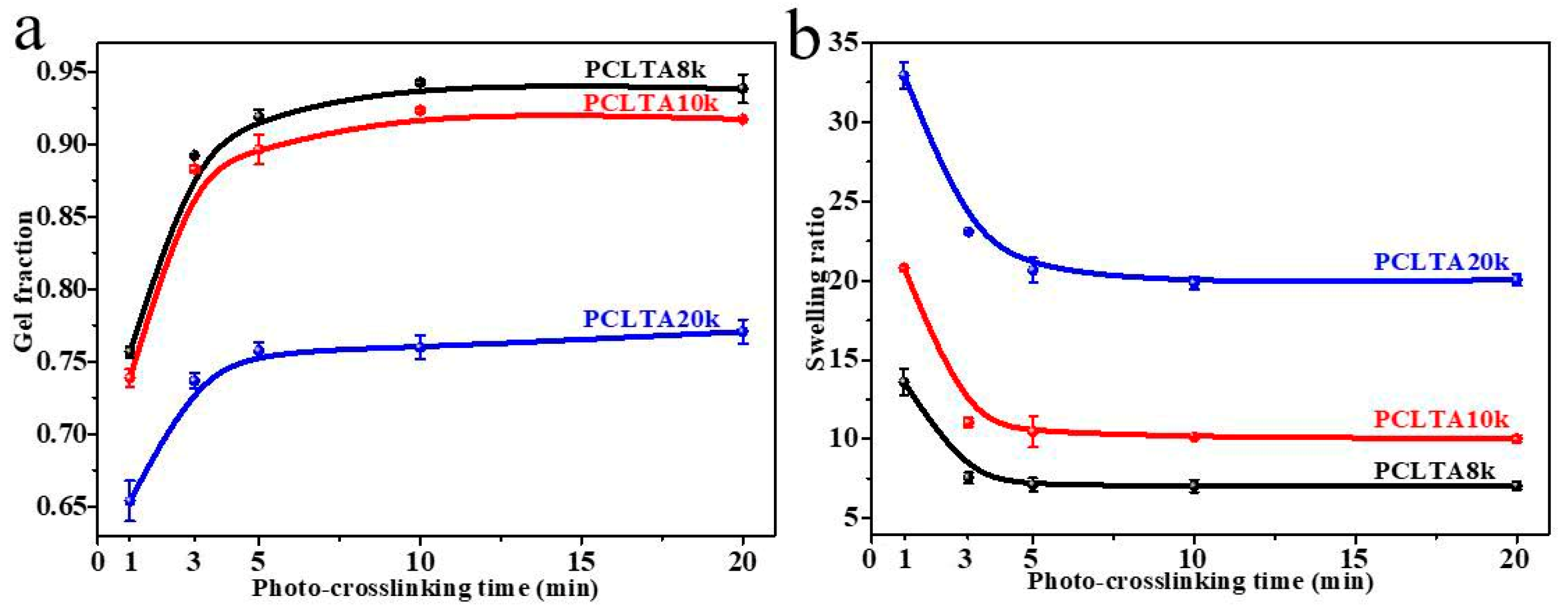

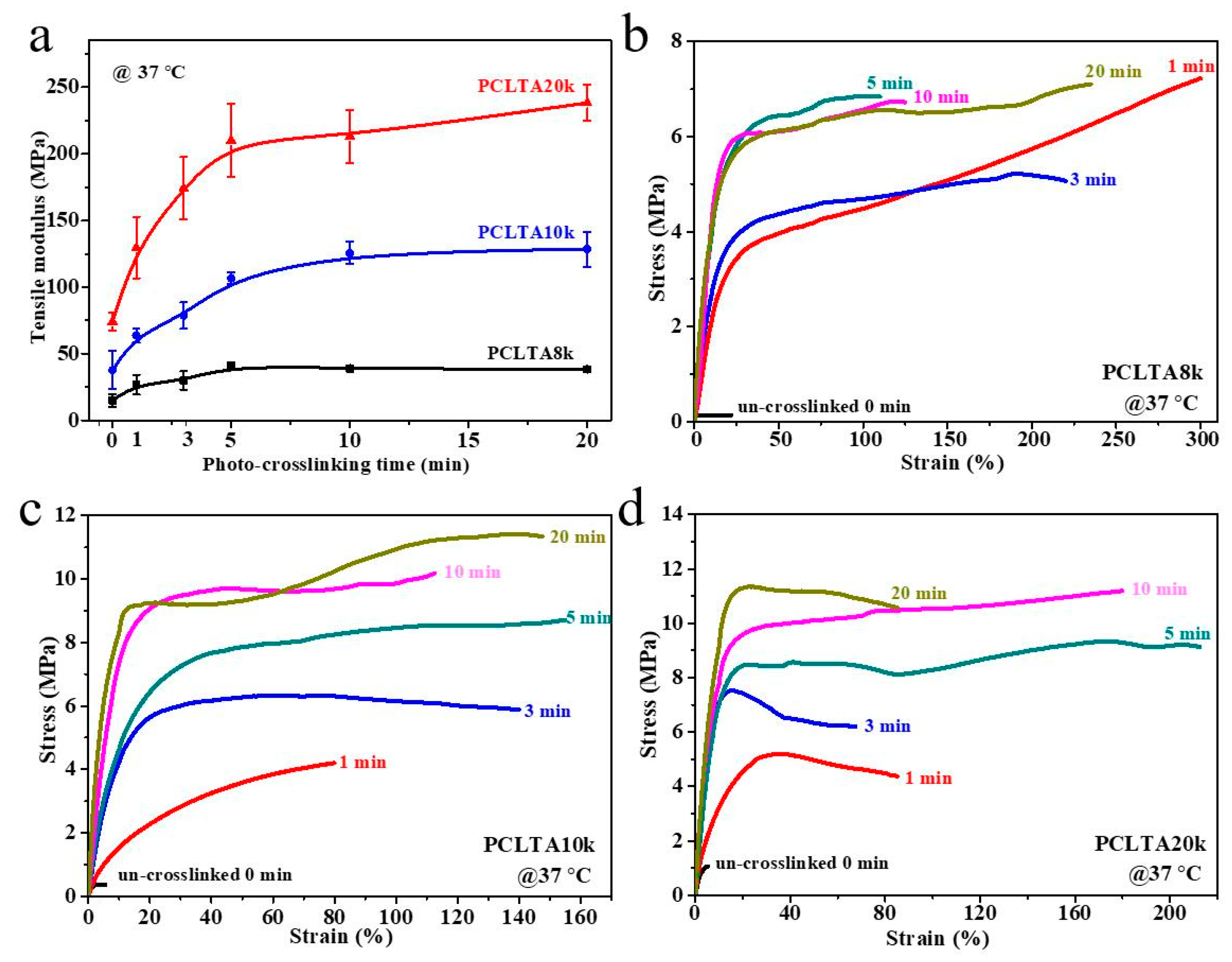
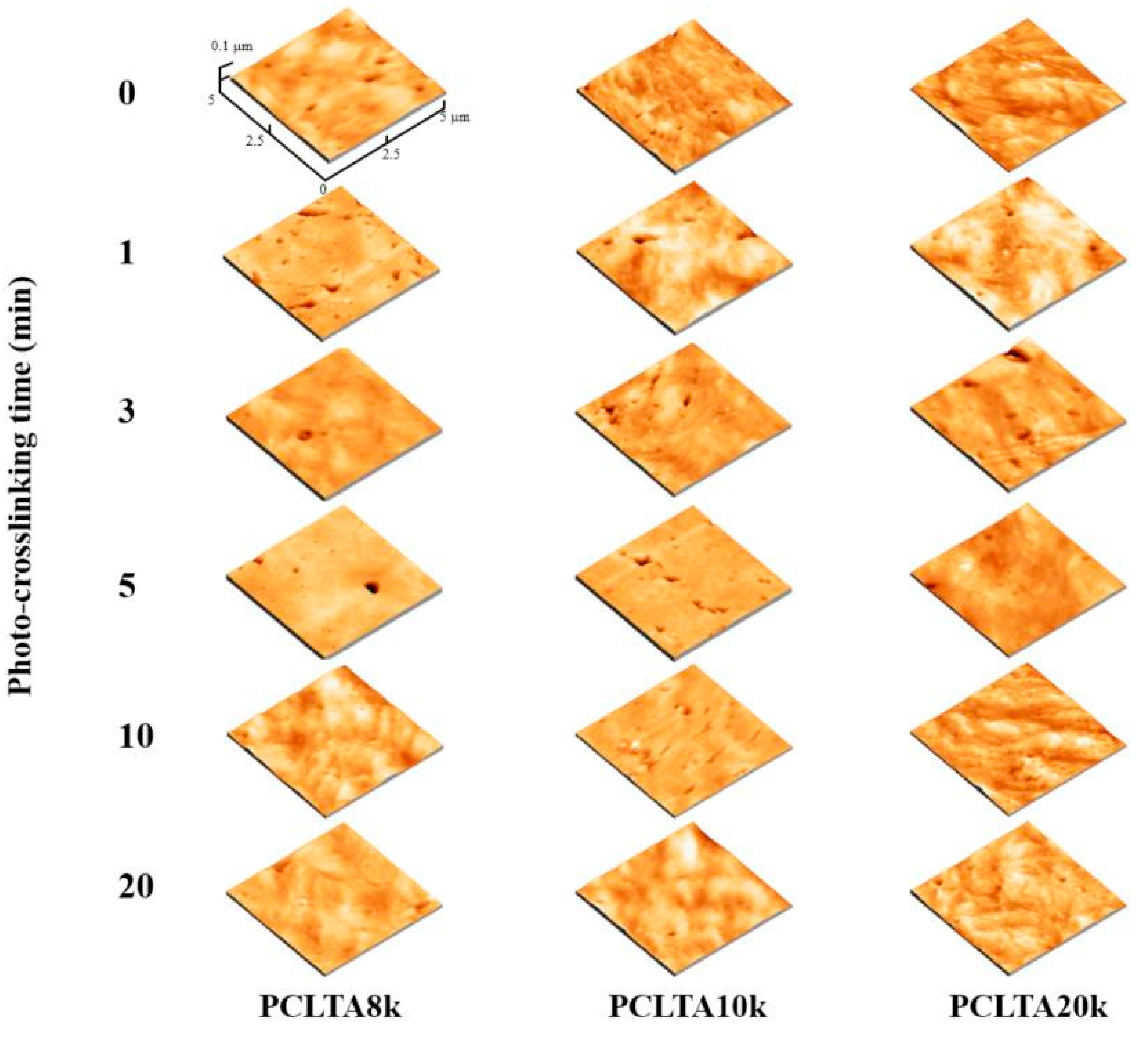
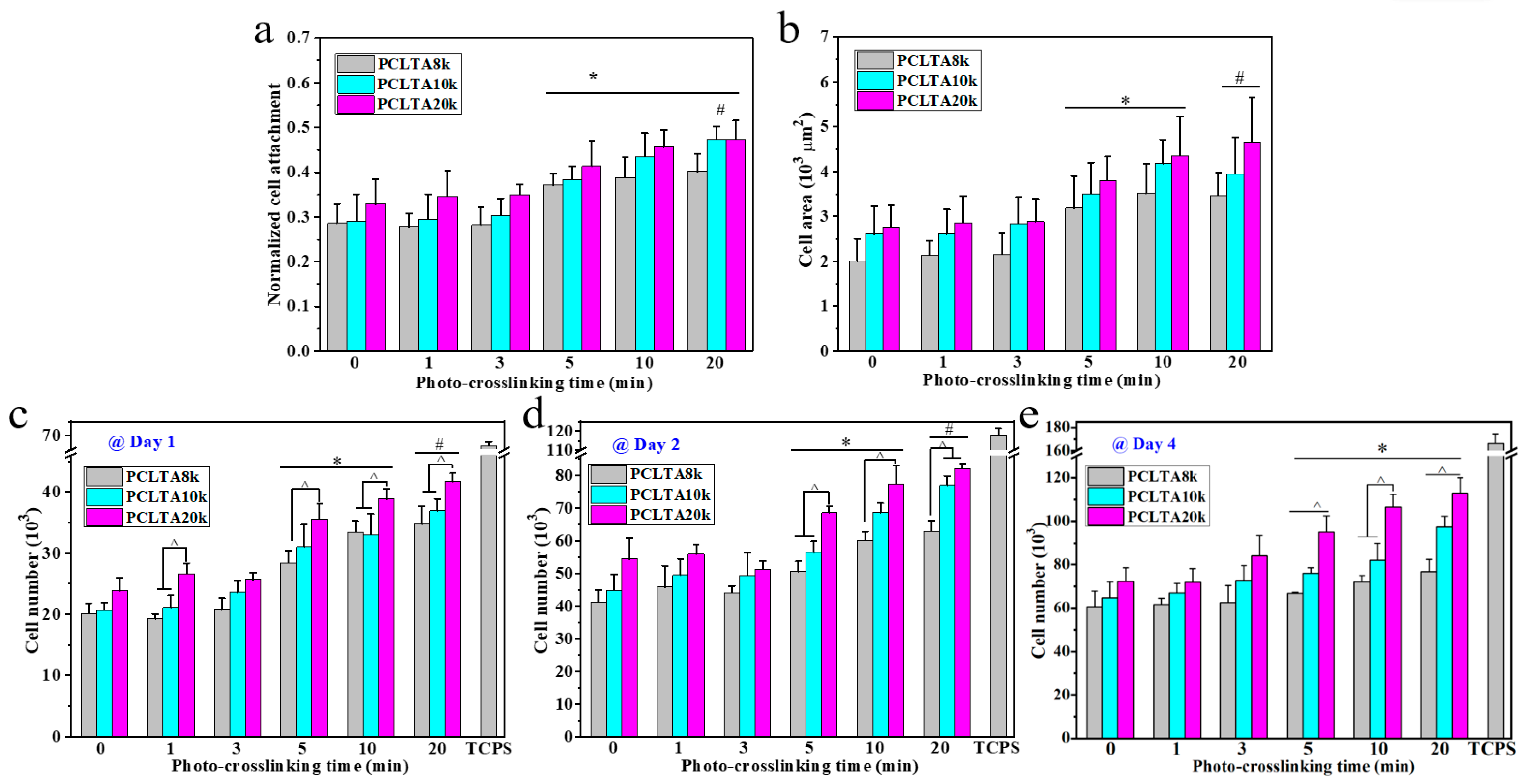
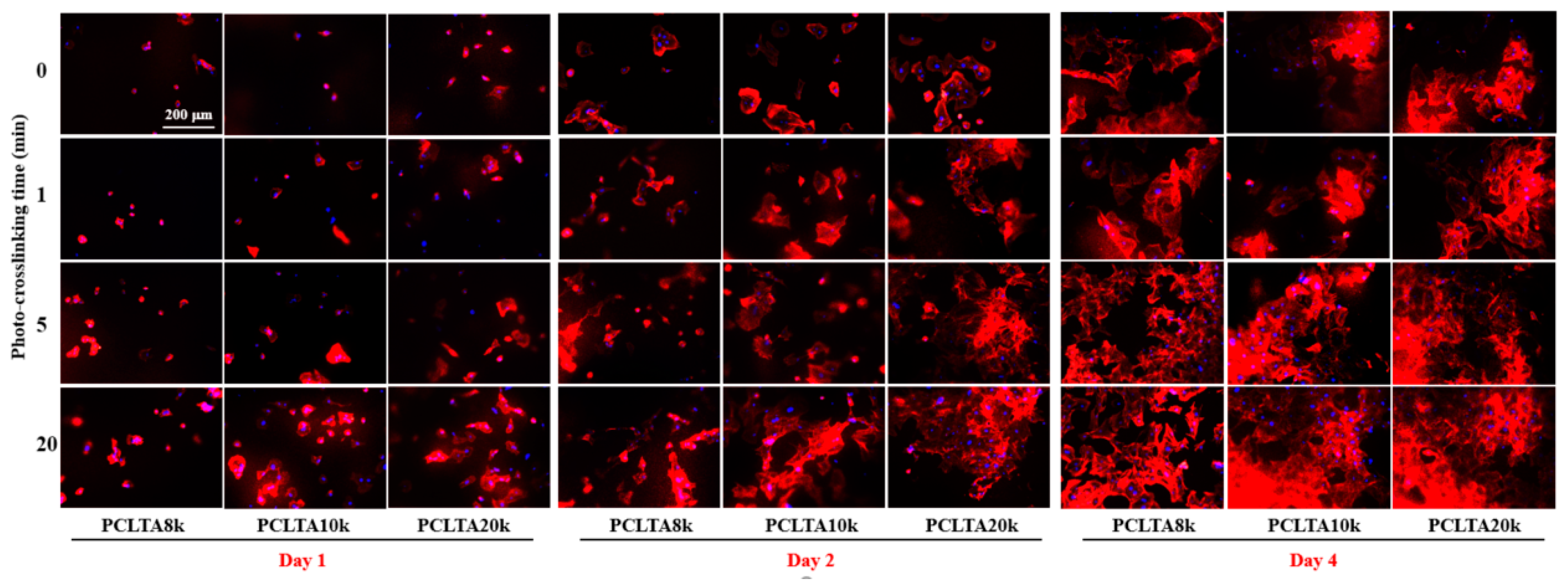

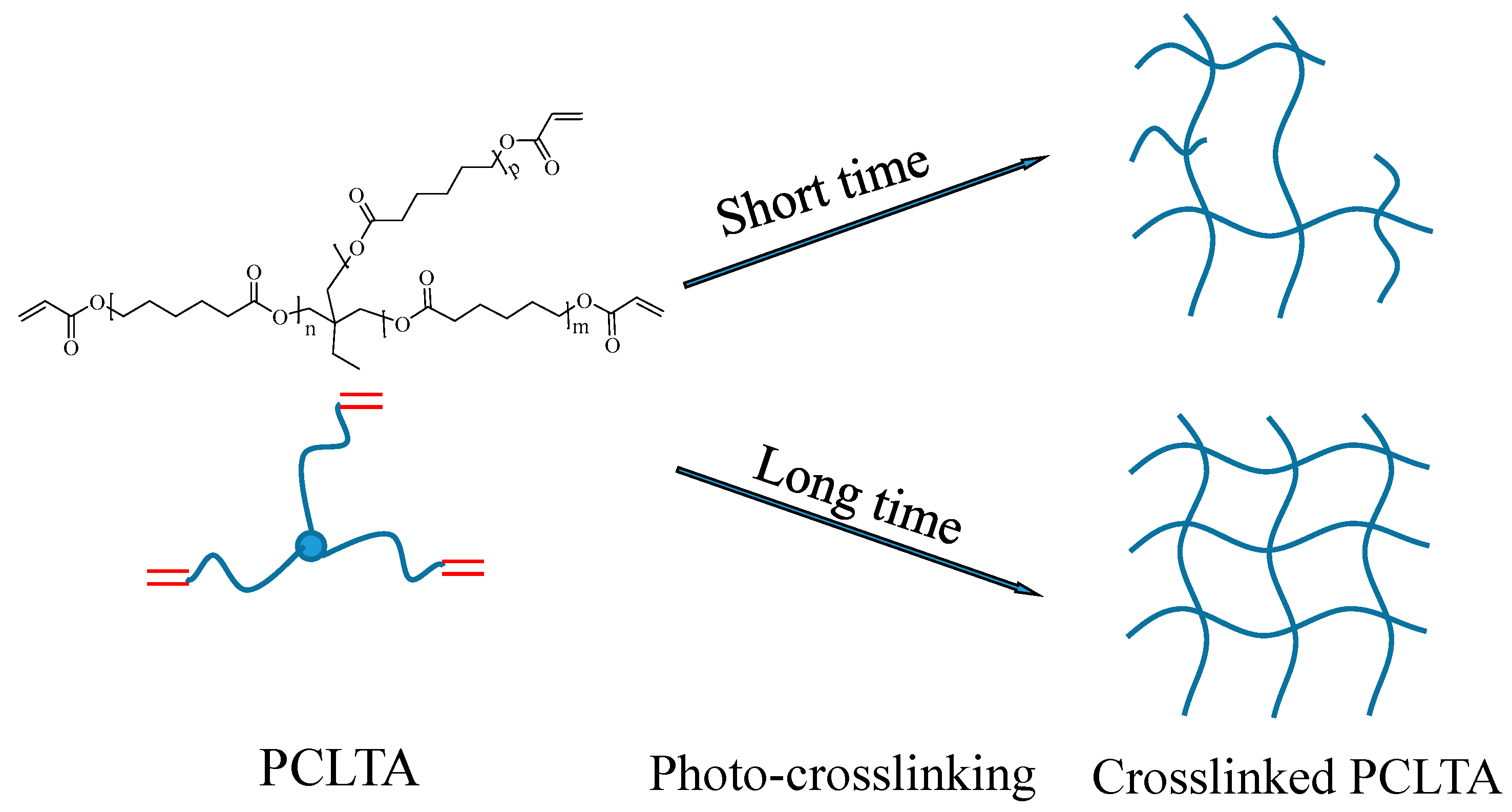
| Crosslinking Time (min) | Tm (°C) | Hm (J/g) | χc (%) | ||||||
|---|---|---|---|---|---|---|---|---|---|
| 8k | 10k | 20k | 8k | 10k | 20k | 8k | 10k | 20k | |
| 0 | 49.4 | 53.1 | 54.9 | 65.8 | 67.4 | 71.4 | 48.8 | 50.0 | 52.9 |
| 1 | 41.4 | 44.0 | 51.3 | 52.2 | 51.4 | 60.7 | 38.7 | 38.0 | 45.0 |
| 3 | 39.6 | 43.5 | 50.8 | 49.5 | 51.2 | 57.6 | 36.6 | 37.9 | 42.7 |
| 5 | 39.5 | 43.3 | 50.9 | 49.0 | 51.0 | 57.2 | 36.3 | 37.8 | 42.4 |
| 10 | 39.1 | 42.8 | 50.9 | 48.0 | 46.1 | 58.0 | 35.6 | 34.2 | 43.0 |
| 20 | 39.0 | 42.7 | 50.7 | 42.5 | 45.5 | 56.5 | 31.5 | 33.7 | 41.9 |
Publisher’s Note: MDPI stays neutral with regard to jurisdictional claims in published maps and institutional affiliations. |
© 2020 by the authors. Licensee MDPI, Basel, Switzerland. This article is an open access article distributed under the terms and conditions of the Creative Commons Attribution (CC BY) license (http://creativecommons.org/licenses/by/4.0/).
Share and Cite
Wang, J.; Liu, L.; Wang, A.; Liu, X.; Zhang, Y.; Wang, Z.; Dou, J. Smooth Muscle Cell Responses to Poly(ε-Caprolactone) Triacrylate Networks with Different Crosslinking Time. Int. J. Mol. Sci. 2020, 21, 8932. https://doi.org/10.3390/ijms21238932
Wang J, Liu L, Wang A, Liu X, Zhang Y, Wang Z, Dou J. Smooth Muscle Cell Responses to Poly(ε-Caprolactone) Triacrylate Networks with Different Crosslinking Time. International Journal of Molecular Sciences. 2020; 21(23):8932. https://doi.org/10.3390/ijms21238932
Chicago/Turabian StyleWang, Jing, Li Liu, Aoning Wang, Xiang Liu, Yi Zhang, Zhoulu Wang, and Jinbo Dou. 2020. "Smooth Muscle Cell Responses to Poly(ε-Caprolactone) Triacrylate Networks with Different Crosslinking Time" International Journal of Molecular Sciences 21, no. 23: 8932. https://doi.org/10.3390/ijms21238932
APA StyleWang, J., Liu, L., Wang, A., Liu, X., Zhang, Y., Wang, Z., & Dou, J. (2020). Smooth Muscle Cell Responses to Poly(ε-Caprolactone) Triacrylate Networks with Different Crosslinking Time. International Journal of Molecular Sciences, 21(23), 8932. https://doi.org/10.3390/ijms21238932





